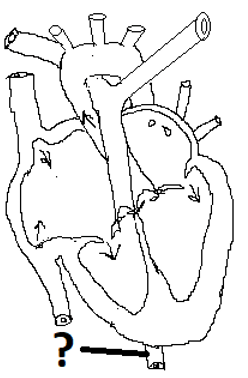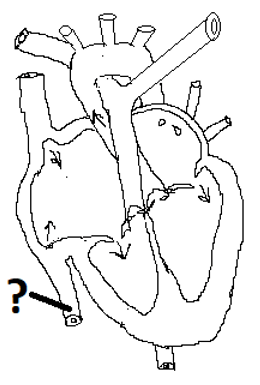This set of Class 11 Biology Chapter 18 Multiple Choice Questions & Answers (MCQs) focuses on “Human Circulatory System – 1”.
1. Which of these is not included in the vascular system?
a) Heart
b) Blood vessels
c) Blood
d) Lungs
View Answer
Explanation: The vascular system or the human circulatory system consists of the heart, the blood vessels-the arteries, the veins and the capillaries, and the specialized fluid connective tissue, blood. The lungs are a part of the respiratory system.
2. Which of these organs are situated in the thoracic cavity?
a) Stomach
b) Kidney
c) Heart
d) Ovaries
View Answer
Explanation: The muscular heart is located in the thoracic cavity of the body. It is located on the ventral side of the body. The stomach, the kidneys and the ovaries are located below the heart and the lungs.
3. What is the covering of the heart known as?
a) Meninges
b) Pleura
c) Pericardium
d) Peritoneum
View Answer
Explanation: The heart is a part of the circulatory system along with the blood vessels and blood. The covering of the heart is a double layered structure known as pericardium which contains pericardial fluid.
4. Which of these structures separate the atria of the heart?
a) Septum
b) Ventricle
c) Purkinje fibers
d) Bundle of His
View Answer
Explanation: The human heart is divided into four chambers-two atria and two ventricles. The septum separates the two atria of the heart. Another septum also separates the two ventricles of the heart.
5. What is the atrio-ventricular septum made of?
a) Cartilage
b) Fibrous tissue
c) Osteocytes
d) Mucous membrane
View Answer
Explanation: The human heart is divided into four chambers- two atria and two ventricles. They pump blood to different parts of the body. The atrio-ventricular septum separates the atria and the ventricles. It is made of fibrous tissue.
6. What is the opening between the right auricle and the right ventricle called?
a) Aortic valve
b) Bicuspid valve
c) Tricuspid valve
d) Pulmonary valve
View Answer
Explanation: The atrio-ventricular septum separates the atria and the ventricles. However, to permit the flow of blood from the right atrium to the right ventricle, there is an opening known as the tricuspid valve.
7. What is the opening between the left atrium and the left ventricle known as?
a) Mitral valve
b) Tricuspid valve
c) Aortic valve
d) Pulmonary valve
View Answer
Explanation: A septum separates the atria and the ventricles. There is an opening between the left atrium and the left ventricle to permit the flow of blood. This is called the mitral valve or the bicuspid valve.
8. What is the location of the SAN?
a) Left upper corner of right ventricle
b) Right upper corner of right ventricle
c) Right upper corner of left atrium
d) Right upper corner of right atrium
View Answer
Explanation: The SAN or the sinoatrial node is located in the upper right corner of the right atrium. It has the ability to generate 70-75 action potentials per minute. It is hence known as the pacemaker of the heart.
9. Which of these structures is close to the AVN?
a) SAN
b) Left ventricle
c) Atrio-ventricular septum
d) Aorta
View Answer
Explanation: The AVN or the atrio-ventricular node is located in the lower left corner of the right atrium. It is situated close to the atrio-ventricular septum which separates the atria and the ventricles.
10. The nodal musculature of the heart is auto excitable. True or false?
a) True
b) False
View Answer
Explanation: The nodal musculature of the heart possesses the ability to produce action potentials on their own, without receiving inputs from nerve cells. Hence, the nodal musculature of the heart is auto excitable.
11. How many action potentials can the SAN generate per minute?
a) 40-60
b) 80-120
c) 12-16
d) 70-75
View Answer
Explanation: The SAN or the sinoatrial node possesses the ability to generate action potentials without receiving any external stimuli. It is auto excitable and can generate 70-75 action potentials per minute.
12. Which of these is known as the pacemaker of the heart?
a) Purkinje fibers
b) AVN
c) SAN
d) Bundle of His
View Answer
Explanation: The sinoatrial node, abbreviated SAN, is known as the pacemaker of the heart. It has the ability to generate 70-75 action potentials per minute, which initiates the contractility of the heart muscles.
13. How many times does the heart beat in one minute?
a) 40-60
b) 80-120
c) 70-75
d) 12-15
View Answer
Explanation: The heart beats 70-75 times in one minute. 72 times is the average number of heart beats for an adult per minute. It is influenced by the activity of the sinoatrial node or the pacemaker of the heart.
14. Identify the part of the heart.

a) Aorta
b) Inferior vena cava
c) Superior vena cava
d) Pulmonary vein
View Answer
Explanation: The diagram given is that of the cross section of the heart. The structure of the heart indicated is identified to be the aorta. It is the largest blood vessel that transports blood to all parts of the body.
15. Identify the part of the heart.

a) Aorta
b) Inferior vena cava
c) Superior vena cava
d) Pulmonary vein
View Answer
Explanation: In the diagram of the cross section of the heart, the indicated structure is identified to be the inferior vena cava. Its function is to carry blood from the lower parts of the body to the right atrium.
Sanfoundry Global Education & Learning Series – Biology – Class 11.
To practice all chapters and topics of class 11 Biology, here is complete set of 1000+ Multiple Choice Questions and Answers.
If you find a mistake in question / option / answer, kindly take a screenshot and email to [email protected]
- Practice Class 11 - Chemistry MCQs
- Practice Class 11 - Physics MCQs
- Practice Class 12 - Biology MCQs
- Check Class 11 - Books
- Practice Class 11 - Mathematics MCQs
